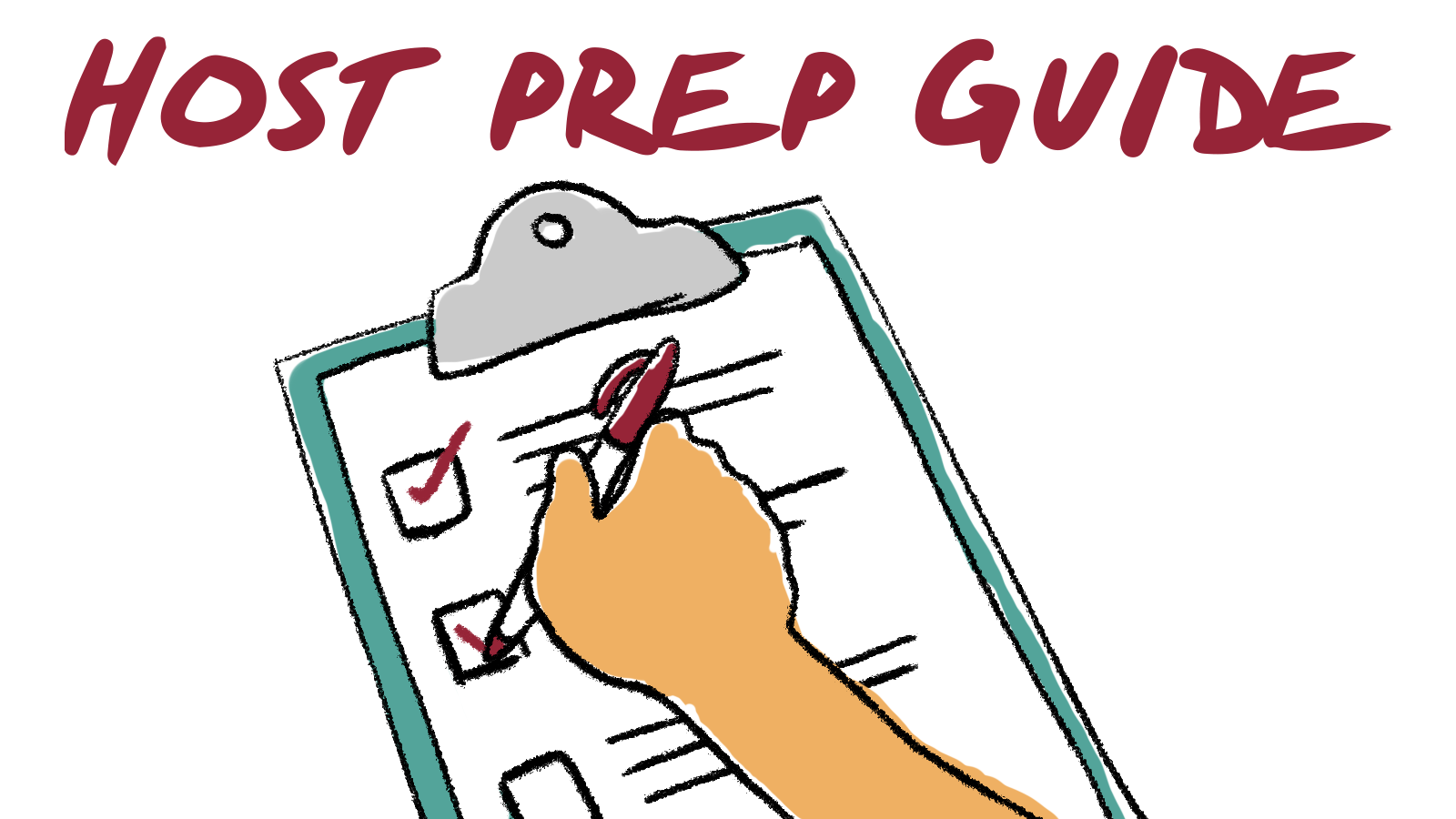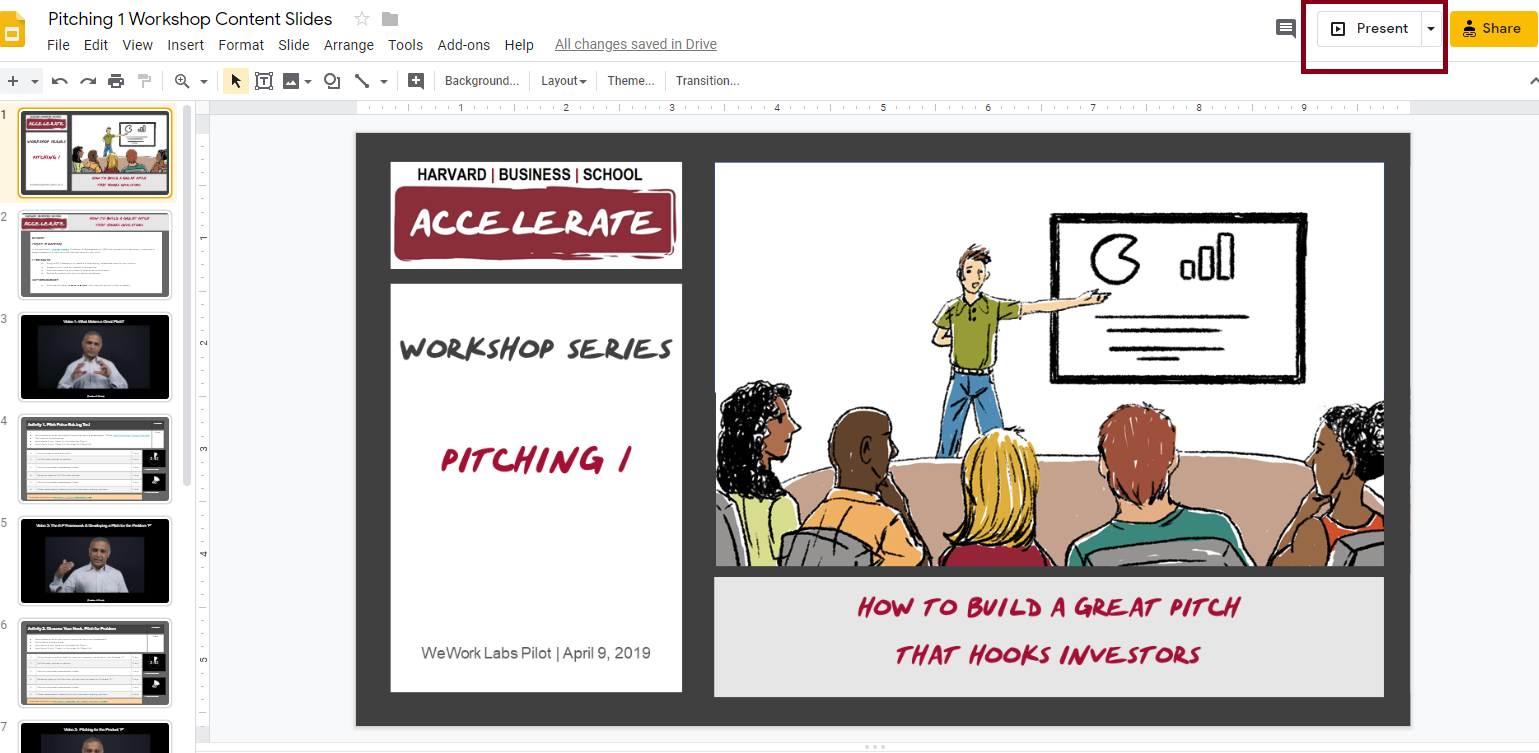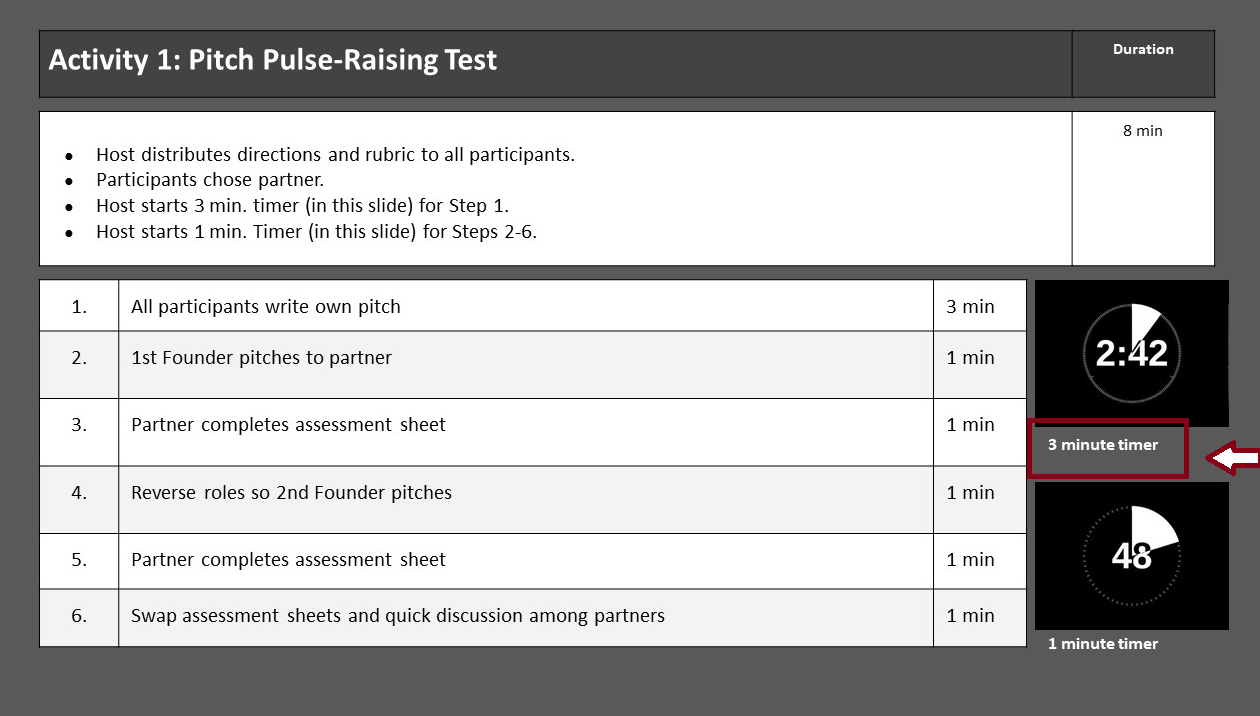Host Prep Guide | How to Build a Great Pitch the Hooks Investors

Overview
HBS Accelerate thanks you for hosting this workshop on Pitching! This guide will help you prepare for the workshop.
- Hosts should be prepared to distribute materials, start and stop videos during the workshop, time activities, and share materials after the workshop.
- While hosts do not need to have content expertise and are not expected to facilitate discussions, they set the tone and enable participants to reap the most from the experience.
- Many of the activities are fast-paced, divided into 1-minute timed sections. Reviewing and understanding timing of activities in advance will help to ensure smooth progression.
What Participants Will Learn
- Factors that influence investors’ decision-making process and how to capture investors’ interest.
- Tested framework to help entrepreneurs build a compelling hook for their pitch.
- How to adapt and refine a pitch’s hook to different audiences.
Workshop Structure
This 60-minute workshop integrates tested frameworks, techniques, tools, and insights delivered by an HBS faculty member via video. Between short videos, participants engage in practical, hands-on activities to help them evaluate and strengthen their startups.
- In order to run in the allotted time and ensure all participants can easily switch between working with a partner and watching videos with the full group, this workshop is designed for 2 to 14 participants. If hosts want to offer the workshop to larger groups and have the space to do so, they have the option of increasing the cumulative time. The format alternates between pre-taped videos of HBS faculty and interactive activities that participants do within the workshop.
- Most activities require participants to work in pairs. See below for suggestions for odd-numbered groups.
- Participants should plan to work with the same partner throughout.
- Activities work best if they choose a partner they don’t know well, who can offer an unbiased opinion.
Pace
If the workshop begins on time and timing suggestions are followed precisely, the workshop duration is 60 minutes. To establish a more relaxed atmosphere, allow for stragglers, and foster time for longer introductions and post-discussion, hosts may choose to advertise the workshop time as 70 or 75 minutes.
NOTE: The workshop operates like a boot camp. It covers a lot of material and moves at a fast pace intentionally. At the outset, hosts may underscore:
- Activities build upon one another, like reps of any exercise, and are designed to prompt founders to think, respond, and assess quickly—in short timed bursts—with a partner. The quick nature of repetitions are important, so hosts should resist the urge to dwell on activities, even if participants ask for more time.
- Participants should not expect to ponder concepts deeply or strive for perfection.
- The quick pace purposefully builds repetition and challenges participants to practice activities under pressure.
- Alternating pitching and assessing—under tight time constraints—with an unbiased partner during the workshop sets the foundation for them to continue applying frameworks to their own ventures beyond the workshop.
Hosts should endeavor to maintain the pace, helping participants move through each exercise in the time allotted. See the Workshop Timing overview in the checklist below for a quick, at-a-glance overview of workshop timing.
Atmosphere & Physical Set Up
- Our goal is to provoke thought and promote active peer-to-peer learning. We provide participants links to resources and hope to help foster an ongoing community of learning, in person and online.
- Participants will work with the same partner throughout the workshop. Choose a space that allows participants to easily turn to one another and work in pairs or small groups, then quickly reassemble into the larger group to view Accelerate videos together.
After the Workshop
- To reap the full benefit and continue momentum, we end each workshop with Beyond the Workshop Action Items, accessible online, that participants can take to continue applying their learnings to their ventures beyond the the workshop (link below).
- This workshop is designed for 2 to 15 participants. The format alternates between pre-taped videos of HBS faculty sharing frameworks and interactive activities that participants do within the workshop. Activities allow participants to gain familiarity with frameworks by practicing with a partner or small group within the workshop.
- Some activities require participants to work in pairs. Note: if you have an odd-numbered group, the host may choose to act as a participant, pair up with the person without a partner, and engage in the activities.
Checklist to Complete in Advance
(download a printable PDF). Links to all materials appear in printable list and in the “Materials to Print and Review” section below.
- READ the Workshop Short Description (link below). This can be used for marketing purposes.
- INVITE participants using language from Workshop Short Description. Print/distribute copies for participants at your discretion.
- READ the Workshop Goals and Structure Overview for Hosts (link below).
- REVIEW the Workshop Timing overview to understand timing and logistics before workshop (link below).
- REVIEW the slide presentation of workshop content. We recommend reviewing slides alongside the workshop timing overview. You’ll display slides during the workshop to deliver content that corresponds with activities.
- PRINT copies of all materials in the “Materials to Print and Review” list below. Be sure to print each activity in advance for all workshop participants.
- Note: each activity is comprised of multiple pages: complete directions for participants to follow and assessment sheets. Be sure to print all pages.
- ASSEMBLE copies of all 4 Workshop Activities (and description if so desired) into complete packets for each participant.
- GATHER extra pens to bring to the workshop to ensure all participants have a pen.
- SELECT an appropriate space work to hold workshop.
- CONSIDER room acoustics and screen visibility to ensure everyone can see and hear videos. Space should:
- Allow participants to easily turn to one another and work in pairs or small group
- Quickly reassemble into the larger group
- View Accelerate videos together on large screen
- CHECK A/V equipment.
Materials to Print and Review in Advance
We suggest hosts print the first 3 items to reference during the workshop and review the slide presentation.
- Workshop Short Description. This includes learning outcomes and speaker bio (1 page).
- Workshop Goals and Structure Overview for Hosts. This includes high-level overview of pacing and activity structure (2 pages).
- Workshop Timing Overview. This provides an at-a-glance overview of video and activity timing. Because the workshop timing is precise, it’s essential that hosts print at least one copy for themselves to refer to during the workshop, while advancing workshop slides. (2 pages).
- Slide presentation of workshop content with the workshop timing overview. You’ll display slides during the workshop to deliver content that corresponds with activities.
Workshop Activities
Hosts must print copies for ALL participants.
- Activity 1 | Pitch Pulse-Raising Test (3 pages).
- Activity 2 | Discover Your Hook: Pitch for Problem (3 pages).
- Activity 3 | Discover Your Hook: Pitch for Product (3 pages).
- Activity 4 | Discover Your Hook: Pitch for People (3 pages).
Materials to Bring to the Workshop
- Pre-assembled packets of all activities for each participant.
- Extra pens for participants.
- Printed copy of Workshop Description, Workshop Goals and Structure for Hosts, and Workshop Timing for host(s) to consult.
Optional Content for Review
This post-workshop content should be completed online and doesn’t need to be printed for participants. Depending on your level of involvement, some hosts may choose to review the post-workshop activities prior to the workshop.
Before Workshop Participants Arrive

- OPEN the slide presentation to display workshop content.
- CHOOSE “Present” so display extends to full screen and only 1 slide displays. Participants should see the workshop title slide as they enter.
- DISTRIBUTE
- Packet of handouts (containing all pages of activities) to each participant in advance. Providing participants with one complete packet of all activities at the outset minimizes distraction between activities.
- Pens, if needed.
- ENSURE you have a printed copy of the Workshop Timing Overview to refer to during the workshop.
- PROJECT slide 1 of slide presentation of workshop content. You’ll advance these slides to display content throughout the workshop.
Workshop Flow
- WELCOME. After participants arrive, advance to slide 2 (“What to Expect”) and set the tone for the workshop, explaining the intentional quick pace and intended results.
- ADVANCE to the next slide (“What You’ll Do”) and review key points, underscoring the importance of giving direct constructive criticism to partner. This is not a time pull punches—directness, blunt questions and honest criticism are invaluable in these exercises.
- ADVANCE to the next slide (“Introductions”).
- LEAD participants in brief (60-second) introductions.
- ADVANCE the slides to display Video 1 (slide 5) and press play.
- ADVANCE to the next slide, Overview of Activity 1: Pitch Pulse-Raising Test (slide 6).
- ENSURE that all participants have directions and assessment sheet.
- Allow participants time to read the directions.
- Follow directions for each activity. SEE BELOW for ACTIVITY information.
- Resist the urge to dwell on activities, even if participants ask for more time. The workshop moves at a fast pace intentionally. Many activities are divided into 1-minute timed sections. Be prepared to start the minute-timer embedded in slides quickly.
- CONTINUE advancing slides in this manner and progressing through all activities.
- ADVANCE to next slide (“After the Workshop”) after watching the final video.
- REITERATE to participants that practicing your hook is essential to pitching. Encourage participants to develop a plan for practicing hook 20+ times, and commit to working with member of workshop to review progress/assessments.
- SHARE the link to the After the Workshop Action Items and Tools that participants can take to continue applying their learnings to their ventures beyond the the workshop.
- ADVANCE to final slide (thank you), after watching the final video.
- THANK the group and ask participants to take survey and share with you any additional questions or feedback they have.
Activity Overview
Format
- All activities in this workshop follow a similar format. Refer to the Workshop Timing Overview (you printed earlier) to time the workshop activities.
- Participants should choose a partner and work in pairs.
- Partners alternate roles: 1) Founder who pitches and 2) Investor who assesses.
-
If you have an odd-numbered group:
- Hosts may choose to act as a participant, pair up with the person who doesn’t have a partner, and engage in the activities OR
- The person without a partner could join an existing pair. In groups of 3, we suggest that participants alternate presenting throughout all activities, following this model:
For each activity, hosts follow the same steps. After watching video introduction of activity, advance to slide with overview of activity (screenshot below).
NOTE: slides have only a basic overview of each activity. Refer to the directions (hyperlinked in the checklist above) for each activity. All participants should have copies of the directions and assessments for each activity in advance.
Steps

- REITERATE that everyone should choose a partner.
- ENSURE everyone has all pages of the activity handout.
- FOLLOW the Workshop Timing Overview (print in advance), using embedded timer to begin each step within the activity.
- START TIMER after pairs are ready. Note: Many of the activities are fast-paced, divided into 1-minute timed sections.
- PREPARE to start the minute-timer embedded in slides quickly.
- DIRECT partners to stop and swap roles, restart timer.
- CONTINUE to follow the Workshop Timing Overview (print in advance), starting the timer again to begin each new step within the activity.
- REASSEMBLE group at the end of all steps in the activity.
- ADVANCE slide and play next video.
- MAINTAIN the pace. The workshop operates like a boot camp.
It covers a lot of material and moves at a fast pace intentionally. Participants should not expect to ponder concepts deeply or strive for perfection. The quick pace challenges them to practice activities with an unbiased
partner so after the workshop they can more easily apply frameworks to their own ventures. Hosts should resist
the urge to dwell on activities, even if participants ask for more time.
Repeat these steps throughout the workshop, following the specific directions in each activity.
After the Workshop
- SHARE the Beyond the Workshop Action Items & Tools.
- SEND participants the following survey.
- Direct url to share: https://bit.ly/2WTvQjJ
- COLLECT participants feedback, observations, and unanswered questions and send to the HBS Accelerate Team.
- ENCOURAGE participants to visit Pitching Workshop 1 | How to Build a Great Pitch that Hooks Investors online to review information, watch videos, download tools, etc.


